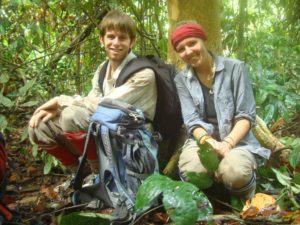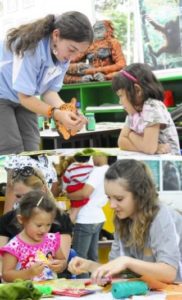 The successful applicants will be expected, in addition to their research projects, to assist with the maintenance and on-going development of the centre and the running of field courses. This placement therefore represents an outstanding opportunity for students wishing to gain experience in tropical forest research and in field centre infrastructure development. They learn about the local biodiversity and way of life and witness the progression of active conservation work throughout the year. PTYs are also in charge of producing DGFC’s newsletter: “The Jungle Times”. A PTY placement normally runs from June, July or August for a full year.
The successful applicants will be expected, in addition to their research projects, to assist with the maintenance and on-going development of the centre and the running of field courses. This placement therefore represents an outstanding opportunity for students wishing to gain experience in tropical forest research and in field centre infrastructure development. They learn about the local biodiversity and way of life and witness the progression of active conservation work throughout the year. PTYs are also in charge of producing DGFC’s newsletter: “The Jungle Times”. A PTY placement normally runs from June, July or August for a full year.
To apply for a PTY with DGFC send a CV (including any evidence of relevant experience in the field) and a cover letter of motives specifying their interest for a PTY position to Dr Benoît Goossens. The final selection of candidates follows an interview with the director and DGFC’s senior staff. Closing dates for CVs and interviews run annually between October and November.
We encourage all selected PTYs to apply for a funds from Cardiff University. To apply, contact the School of Biosciences’ PTY Placement Coordinator for more information.
For any additional information, please contact Dr Benoît Goossens by email.
To see examples of the projects that can be pursued at DGFC, check out our current and previous PTYs.
The COVID-19 pandemic has put the PTY program on hold. It is expected to continue in for 2022-2023.
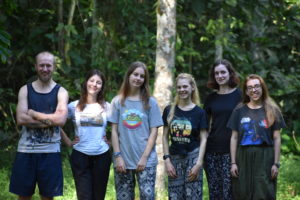
This year we also welcomed two PTYs from Swansea University (report and personal project not required by their university):
Kirsty Leach
Tyler Cuddy




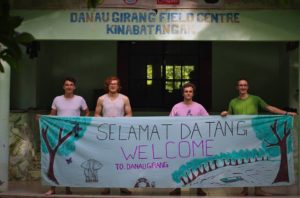


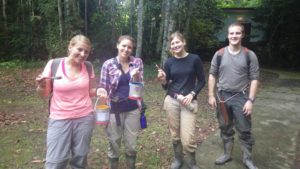
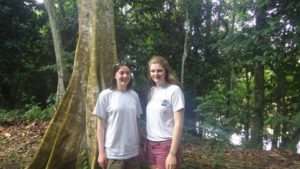
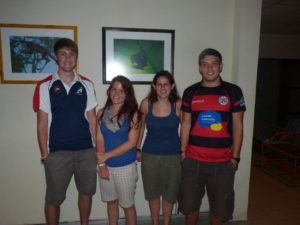


| Name | Project |
|---|---|
| Alice Evans | Habitat and microhabitat use of anurans in a Kinabatangan forest fragment |
| Jenny Shepperson | Small mammal habitat preferences in secondary logged forest, Borneo |
Examples of research projects by PTYs
Anya Tober, Cardiff PTY, 2013-2014
Field supervisors: Benoît Goossens and Sergio Guerrero-Sánchez
Abstract
Habitat fragmentation and loss is a major threat to tropical rainforests, especially those in Southeast Asia. Agricultural development has left the Bornean state of Sabah with highly fragmented secondary forest interspersed with oil palm plantations. Such alteration in habitat can have a great impact on host-parasite dynamics. The water monitor lizard, Varanus salvator, is the most common species of monitor lizard in Malaysia and is known to inhabit a number of habitat types including forest and oil palm plantations. This study aimed to assess the impact of habitat alteration and fragmentation on the host parasite interactions of V. salvator in the Lower Kinabatangan Wildlife Sanctuary. The prevalence and intensity of ectoparasites and haemoparasites was compared in lizards caught in the secondary forest and oil palm plantations. Lizards were trapped along transects consisting of 5 traps at 300m intervals. A total of 12 transects were sampled, 6 in forest sites and 6 in plantation sites which were then split into interior and edge sites. Tick mean intensity was significantly higher in the interior sites than edge sites. Attempts to assess the abundance of ticks in the environment by drag sampling were unsuccessful. Haemogregarine mean intensity was significantly higher in lizards captured in the forest than in the plantation and was significantly higher in edge sites than interior sites. There was a significant negative correlation between haemogregarine infection and the total cell count and a significant positive correlation between haemogregarine infection and the proportion of immature erythrocytes. This study showed that the habitat alteration and fragmentation caused by the development of oil palm plantations and the subsequent edge effects alter host-parasite interactions of V. salvator. The findings of this study provide the foundations for further epidemiological research involving the alteration of habitats and the dynamics of zoonotic diseases.
Aimee Holborow, Cardiff PTY, 2014-2015
Field Supervisors: Benoît Goossens and Sergio Guerrero-Sánchez
The Asian water monitor (Varanus salvator) is a prevalent species within the rainforest of Sabah, Borneo, and of the Varanid species, it is believed to be the most widely dispersed. V. salvator face multiple threats, a significant factor of which being fragmentation. Alteration of habitat and thus organism ecology through fragmentation may in turn implicate host-parasite dynamics. This study focuses on gastrointestinal parasites of V. salvator lizards and potential effects on parasite burden imposed by habitat fragmentation in the divided forest landscape of the Kinabatangan Wildlife Sanctuary, Borneo. Seven transects, each 1.2 km in length, and comprised of five traps each separated by 300m, were utilised in this study. Trapping was carried out of 15 days at each site, with the main intention being to establish any differences in intensity and richness of V. salvator gastrointestinal parasites between forest and plantation. To measure individual lizard parasite burden, faecal samples were analysed using flotation with over-saturated saline solution (NaCl), followed by a modified McMaster egg counting technique, 32 different parasite eggs were obtained, consisting of 19 helminths (nematodes, cestodes and trematodes), 6 Protozoan, and 7 unidentified species. No significant difference was observed for overall parasite prevalence, mean intensity and species richness between forest and plantation. However, trematode and protozoa parasite groups did show significant prevalence variances between forest and plantation, with protozoa infections appearing non-existent in forest. Additionally, no significant effect of trapping near riparian zones was found. When comparing abundance to both lizard’s snout to vent length (SVL) and body condition, no significant relationships were observed. This study indicates no overall effect of habitat fragmentation on V. salvator gastrointestinal parasite burden. Parasite group differences however, potentially suggest the occurrence of more species-specific fragmentation effect.
Stephen Edwards, Cardiff PTY, 2014-2015
Field Supervisors: Benoît Goossens and Meaghan N. Evans
Temporal partitioning of activity among sympatric mammalian carnivores can play a vital role in facilitating species coexistence. High overlap of two species’ activity patterns may indicate difference in other resource use, while low overlap may indicate temporal avoidance to reduce interspecific competition. Camera trapping was used to assess species assemblage, activity patterns and temporal overlap for the carnivores of the Lower Kinabatangan Wildlife Sanctuary (LKWS), Sabah, Malaysia. Between November-2010 and May-2015, intensive camera trapping was conducted in the Kinabatangan floodplain. The study covered 24,506 trap nights producing 2,327 independent events for 13 of the 25 Bornean carnivores. Kernel density modelled activity patterns were created for 10 of these 13 encountered species which included the first in-depth activity pattern produced for the Malay badger (Mydaus javanensis). Activity patterns of carnivores in the LKWS were generally in line with previously reported values. Overlap analysis was also conducted between each of these 10 species and overlap varied greatly within the species analysed. Temporal overlap within the Viverridae and within the Felidae analysed was high, indicating niche partitioning occurs within a different ecological dimension such as spatial or dietary. Certain overlaps, however, such as that between the yellow-throated marten (Martes flavigula) and the leopard cat (Prionailurus bengalensis) showed low overlap which may indicate temporal avoidance to reduce interspecific competition. Of the 13 carnivores present, six are Threatened on the IUCN Red List, indicating the importance of the LKWS as a conservation area. The high species diversity and prolonged presence of charismatic flagship species such as the Sunda clouded leopard (Neofelis diardi) and sun bear (Helarctos malayanus) also adds weight to the biological importance of the LKWS. The results of this study will allow a better understanding of the species diversity persisting within fragmented landscapes and act as valuable baseline data for future conservation actions.
Sarah Joscelyne, Cardiff PTY, 2013-2014
Field Supervisors: Benoît Goossens and Meaghan N. Evans
The factors mediating species’ dietary preferences have received much attention in ecological literature, due, in part, to their potential importance in influencing the structure and functioning of ecological communities. In this study, we characterised the diet composition of a little studied small carnivore, the Malay civet (Viverra tangalunga) which resides within a forest/ agricultural matrix in Sabah, Borneo. We investigated the factors influencing Malay civet diet choice and explored the potential role of the species as seed dispersers in this landscape. We found Malay civets fed upon a range of dietary items, with fruit being most prevalent. Plantation and forest diets were significantly different, and variability was found even more so between seasons. Diet shifting over time was a common phenomenon within forested habitats, but not in plantations. Optimal foraging likely drives civet diet choice and, as a result, fruit availability directly affected the presence of seeds in scats. In relation to the high consumption of fruits, Malay civets defecated viable seeds and so contribute to the floral ecosystem. These findings confirm that Malay civet diet varies spatially and temporally and are therefore able to adapt to ever changing environments with habitat conversion and degradation, and seasonal variations.

